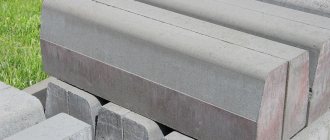In terms of quality characteristics, concrete brick is superior to building materials made of wood and clay. It has good thermal conductivity, does not collapse under the influence of frost, and does not burn. The building material is produced by strong pressing or by processing at high temperatures. Walls made of concrete bricks are highly durable and resistant to adverse environmental factors.
Types of building materials
Full-bodied
The use of cast bricks reduces the delivery time of the finished object.
For heavy construction, solid material is used. The bricks have a rectangular shape, are distinguished by their volume and uniformity of structure. Cast concrete building material can withstand long-term intense loads without signs of deformation or rotting. They are used to lay load-bearing walls in high-rise apartment buildings. When laying strip foundations, concrete bricks fill the resulting voids. After filling with cement, the structure becomes monolithic.
A material with such a structure is resistant to various deformations.
Hollow
This type of concrete brick acquired its name due to the presence of two cavities inside each stone. Unlike cast building materials, embossed bricks cannot be used for foundations and in multi-story construction. Due to its high levels of noise absorption and sound insulation, hollow cores are used in the construction of buildings no higher than 3 floors, country houses, and interior partitions in residential and industrial premises.
Facing
Decorative brick is cast in structure, but its front side is embossed, reminiscent of wild stone. It can be lined with a brick wall for decoration and additional insulation. Processing of wooden surfaces is possible. Facing concrete stones have a large selection of colors and allow you to create decorative compositions on the walls.
This material is not suitable for the construction of high-rise buildings.
The material serves as an external decoration of buildings.
When is a foundation needed?
The first thing you need to figure out is for what cases it is optimal to use brick for the foundation. Although, from a technical point of view, this option is applicable for any structures, in practice it is used exclusively for one-story buildings of light weight. It is not recommended to build a huge two-story brick house on such a white foundation. But for an extension or for the construction of a small bathhouse, veranda or modest white summer house, the material is suitable. A brick foundation is distinguished by a set of certain positive and negative aspects that are important to consider in the process of preparing for work. In addition to the main material, the brand of concrete, type of soil and insulation used in the work also play an important role.
Brick is suitable for decorating strip and column bases: the main thing is to prepare a reliable base.
Advantages and disadvantages
If you use concrete stone for its intended purpose, then inappropriate financial costs are eliminated, and therefore it is difficult to find the disadvantages of this building material. The advantages of concrete stone include the following properties:
- Thermal conductivity. Brick keeps the room warm and maintains a normal level of humidity.
- Strength. To make a hole in concrete brick, diamond drilling is required. This material is superior in strength to ceramic and silicate bricks.
- Fire safety. Concrete stone is a fireproof material.
- Resistance to low temperatures. Does not deform when exposed to extreme frosts.
- Environmental friendliness. Finished products are absolutely safe for human health. They do not have background radiation like granite.
- Availability. It has an acceptable cost, which makes concrete stone a popular building material.
- Durability. Structures made of concrete stones are not damaged by insects and rodents, do not become moldy, and retain their strength and appearance for decades.
Holes in such material are made using a diamond drill.
What is concrete brick
Concrete brick is a building material that is the most durable and reliable of all those available on the market. It is not afraid of the harshest climate and remains attractive in any conditions.
What does concrete brick look like?
A similar type of modern concrete brick was known to ancient Greek builders and architects. The structures erected from it are impressive, proving that man became intelligent a long time ago, even then in his desire to leave a bright mark on the Earth, to “tell” about his culture; proved the consistency of his own knowledge and skills.
Production capacity and level of automation in modern conditions make it possible to produce concrete bricks and blocks of various types. Any model that meets production requirements can be obtained. Using advanced technologies, products acquire reliable qualities.
The composition and production method make it possible to distinguish three volumetric groups of bricks: silicate, ceramic and concrete.
Where is it used?
Due to their quality properties, concrete stones are used for the construction of objects that will be subject to constant high humidity, for example, for laying swimming pools and wells.
The properties of the material make it possible to build a pool from it.
The areas of application of concrete bricks have no restrictions. It is used in heavy construction for laying and pouring foundations, laying strong load-bearing walls in high-rise buildings. This type of building material is used for the construction of fences, residential and utility buildings, interior partitions, plinths, basements, and swimming pools. Concrete facing bricks are used for decorating and insulating brick or stone walls and fences.
Characteristics
A characteristic feature of the products is that they:
Comparative characteristics of wall materials.
- have universal sizes;
- have a wide range of products;
- have a luxurious range of colors;
- not subject to rotting and the destructive action of insects;
- are characterized by high fire resistance.
Thanks to the good technical characteristics of this material, it is possible to perform high-quality insulation of the interior of the room from weather precipitation and noise effects.
Facing bricks have a lot of advantages, which is what attracts consumers.
Such products are characterized by the fact that they are able to withstand fairly high loads, which for many other materials are considered simply critical, and are well suited for lag. In addition, the block has high strength.
Assessment of thermal conductivity of materials.
These materials can be called energy-saving, therefore, when using them, you can save not only on building mixtures, but also on heating in the winter.
They are quite resistant to high humidity, so this is the best option for any region. Durability can also be noted, but subject to absolutely all rules during production.
They adhere well to the solution, so they provide particular ease of installation.
Production Features
Composition of building materials
Concrete stones are considered an environmentally friendly replacement for clay materials with the increased strength of the former. The brick mixture is based on concrete, which differs in grain size depending on what properties the finished product should have. Mineral substances such as gypsum or cement are used as fillers. Sand must be added.
The material is made from cement and various aggregates, which are used in certain parts.
The working process
The method of producing stones from concrete is called hyper-pressing. The manufacturing process of building materials is divided into the following stages:
- Preparation of constituent components and their mixtures.
- Control of the amount of dry substances for the concrete mass, mass measurement.
- Preparation of a homogeneous solution with all necessary additives.
- Formation of products and sending to the press.
- Heat and moisture processing of finished stones.
- Marking of finished building material. Packaging and transportation to the warehouse.
View "GOST 6133-99" or
The production of stones from concrete is carried out in accordance with GOST 6133-99. The standard size of the finished product is 250×120×65, but variations are possible for stones used in the construction of load-bearing structures and decoration. For repair work or simple construction that does not require the use of high-strength material, concrete stones can be made independently.
How to make concrete bricks at home?
You can make stones yourself using ready-made mixtures, which are sold in construction stores, packaged in 18-36 kg bags, or you can make a solution from cement, sand and aggregates, adhering to generally accepted proportions. Before starting work, you need to prepare metal or plywood forms for the stone, which are treated with any lubricant before pouring concrete.
The concrete solution should not be too thick so that there are no voids left in the finished bricks. After the molds are filled with the mixture, they are left for a day so that the stones acquire the desired shape. Then the products are removed and placed in a cool room for 2 weeks, covered with a wet blanket and film. It is important to keep the wet “compress” on the bricks during the entire hardening period to prevent them from cracking.
Sizes, brands
The required type of raw material must meet the following requirements:
- to be whole, without voids;
- frost resistance level – from 35 cycles and above;
- water absorption – no more than 16%;
- compressive density – 1600 kg/m3.
Photo: masonry process
Ceramics should be of the following brands: M150, M200, M250.
Suitable brick sizes:
- 25*12*6.5 cm – single;
- 28.8*13.8*6.5 cm – modular;
- 25*12*8.8 cm;
- 28.8*13.8*8.8 cm.
We recommend that you read the article: “Lime mortar”.
Materials for masonry
You can lay out a reliable foundation with your own hands, having previously prepared high-quality material. Often used bricks are used for this purpose. It has stood the test of time, the defects have already appeared. However, it must be taken into account that the frost resistance of the product is designed for a certain number of cycles. A new ceramic unit is taken with a class from F 35 to F100, a used one is unknown.
According to the manufacturing method (firing), red solid brick is significantly superior to silicate brick in its ability to withstand moisture. Therefore, only such stone is suitable for the load-bearing part of the house.
Watch the video on how to choose the right material for laying the foundation of a house.
Advice from professionals
The masonry should be reinforced every few rows of bricks
- When laying walls made of sand-lime bricks, there are several ways to bandage the seams. This is necessary to make it stronger. The most common method is vertical. Longitudinal bandaging will ensure uniform distribution of the load on the wall along its entire length, helping to avoid vertical delamination. Transverse ligation will ensure good longitudinal connection of the bricks.
- To build a strong wall, reinforcing mesh is periodically placed between the rows. Thanks to its use, you can avoid the appearance of cracks in the wall.
- Before starting work, it is better to dip the bricks in water so that they do not draw liquid from the mortar.
- Experts do not recommend that beginners immediately start laying sand-lime bricks on the mortar. It’s better to learn how to adjust stones to each other without it.
- It is recommended to lay no more than 10 rows of bricks per day. If you do not follow this rule, the walls may swell and you will have to reposition them.
- Professionals recommend laying the first row of bricks without mortar first, in order to quickly trim if necessary. If you apply the solution right away, further trimming can be very problematic.
- In order not to periodically run for materials during construction work, you should prepare everything in advance. This, first of all, concerns the supply of bricks, which are laid out in small blocks along the wall being built.
- The mortar is usually mixed a little, but if laying the wall takes several hands, you may have to resort to using a concrete mixer.
Laying sand-lime bricks with your own hands can be done by a non-professional, subject to the above simple rules. If you have any questions regarding technology, please contact our experts.
Making corners
Now, using the knowledge gained, we set the corners brick by brick. The main thing is not to forget that the quality of the masonry of the entire wall will largely depend on how correctly the corners are set. Therefore, we use both an eye and devices that will help us in setting angles.
Using a plumb line, we check the verticality of the masonry. A plumb line is considered a very accurate device for checking the verticality of a surface. Probably the simplest and most accurate compared to the building level, which can sometimes fail. There is no point in using a plumb line when we have 1-2 rows of masonry laid, since it is difficult to determine by eye the discrepancy from the vertical in such a small area.
In the picture we have displayed 3 points equally distant from the masonry. Based on the fact that the distances in these segments are equal, we can conclude that our masonry is laid out exactly vertically. To work with a plumb line, you, of course, need to have a good eye, since we determine all the distances between the masonry and the plumb line visually, by eye.
To maintain identical horizontal seams and to control the horizontalness of the masonry, we recommend using rows. They will be especially useful for people with little experience in bricklaying. The orders are established strictly vertically (plumb or level) and are attached to the masonry using U-shaped brackets. The distance between the order divisions is 77mm for a single brick (brick thickness 65mm + seam 12mm) and 100mm for thickened bricks (88mm + 12mm).
Work order
According to the technology for laying a plinth with bricks, the first row must be laid out dry - without using mortar. This is necessary for better planning of the row, where mostly whole brick products will be used for masonry. After this, work is carried out on marking sections of vertical seams. The laying of the basement always begins with corner elements, which will serve as reference areas for the further construction of walls. To do this, a strong cord is pulled with extreme precision between the perpendicular rows that make up the angle.
When performing such work, it is better to use ordinary red brick, since it is not afraid of a humid environment and salt deposits. The first row is laid out perpendicular to the walls. To form a zero mark on the foundation relative to the horizon line, they are oriented along a line drawn along the level of the rope. During the laying process, a thin cement mortar is used to facilitate alignment of the brick fragments.
Each row of brickwork forming the plinth must be checked by the building level
This will ensure more accurate compliance with the horizontal surfaces and prevent distortions of the base, which is important for further work on the construction of the main load-bearing walls. According to building codes, the last row of masonry in the basement must be covered with a layer of waterproofing material
This will prevent moisture from penetrating the external walls of the structure.
Half-brick masonry
When laying half a brick, the most important and crucial moment is to lay out the first row correctly.
What is half-brick masonry?
Half-brick masonry is considered the easiest to construct. It is used in the cladding of buildings, the construction of internal walls, in the construction of sheds, gazebos, fences, and so on.
With this method, the bricks are laid in a row with a tape, on the mortar, touching with the butt side. The front side of the walls consists only of the spoon part. Therefore, the thickness of the walls is equal to the width of the brick itself, namely one hundred and twenty millimeters.
Each subsequent row is laid out with a shift of half a brick. As a result, the middle of the top brick coincides with the connection of the bricks of the previous row. This creates a strong bond between the brick rows.
Mason's tools
Naturally, in order to beautifully lay out a half-brick wall, you need to prepare. First of all, check that you have the necessary tools for the job.
You will need:
- Concrete mixer;
- Bucket for solution;
- Mortar shovel;
- Master OK;
- Rubber hammer;
- Hammer-pick;
- Mason's Corner;
- Cord-mooring;
- Pencil or felt-tip pen for marks;
- Plumb;
- Level and others.
And other materials means that each mason can have his own set of tools that are convenient for him.
These can be various devices for laying mortar, for fixing seams, and so on. Of course, you can do without them, although their presence will speed up the work several times.
Preparatory work
As mentioned above, the most important point is laying out the first row. In order for the wall to be smooth, neat and beautiful, an even, almost perfect foundation is required.
If it is far from ideal, has large horizontal discrepancies, and a wavy surface, then it will be very difficult to achieve good results.
Therefore, the preliminary work consists of leveling the surface for the masonry. When the foundation is properly prepared, tightened, strengthened, you can begin waterproofing.
Calculation of the first row of masonry in 1/2 brick
So, let’s imagine that the surface for laying is completely ready. There is no need to rush to lay out the first row correctly.
You don’t want to have to redo everything all over again later. The first row of bricks is laid out without mortar, with vertical joints measured.
For example, you took a steel rod with a diameter of 8 millimeters. They laid the entire row of bricks, from the starting point to the ending point, fixing the distance between the bricks.
You will never be able to lay out a row perfectly the first time; in the end you will definitely end up with a mismatch. And here you need to look at the circumstances.
If there is a gap of two or three centimeters, then you can move the bricks apart a little. For example, instead of 8 millimeters of vertical seam, make 9 millimeters.
And vice versa, if the last brick does not fit in a little, then make all the seams narrower by half a millimeter.
That is, your task is to lay out the first row of bricks as evenly as possible, with equal spaces between them. When the desired result is achieved, make marks on the foundation.
Laying the first row
Laying the first row should begin from the corners. Or rather, from the highest corner of the foundation.
A corner brick is laid on the mortar and leveled strictly. Next, its height is fixed using a water level.
After this, the brick is fixed in the same way in its previously marked place on the other corner of the building. The brick is fixed to the same height using the water level.
And so all 4 corners pass. Then, between the corner bricks, a mooring cord is pulled using a corner.
Only after this can you begin laying the first row on the mortar. At the same time, be sure to look at the marks made so that the brick lies in its place.
Second row
The second row is laid out, as mentioned above, in a checkerboard pattern. Also, first the corners are secured and the mooring cord is installed.
When laying bricks, you need to ensure that the vertical seam of the previous row is strictly in the middle of the brick.











